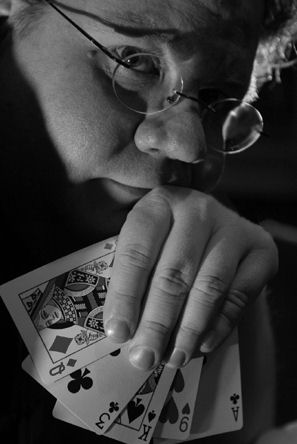November 12 – Saturday
There will be only two events on Saturday, a field trip and
the big show.
Brookledge
The second field trip of the Conference is to what is called’
“the most famous address in magic.” I guess for the west coast centric magic community
that may be so. I expect so Midwesterners or east coasters may have their own
choices. Either way this private residence is home to a long and great magic
legacy.
In 1930, Floyd Thayer opened his Studio of Magic in his
home. It was named Brookledge because out behind Thayer built an addition on
the home which transverses a small brook that runs though the back yard. This
housed his workshop and an ornate theater.
The theater was used as a demonstration platform for the new
Thayer products. Every Saturday afternoon magicians, notable or not, would
gather in the theater to watch the Thayer demonstrator show off the newest in
magic.
The aim of the presentation today was to give us an experience
of one of those afternoons. It was a huge success.
We were transported to Thayer’s 1942. Mike Caveney emceed
and gave some historical tidbits, like that Orson Wells rehearsed his Mercury
Wonder Show on that stage. He then introduced the newest of the Thayer
demonstrators, the young Marvyn Roy.
Okay, Mr. Electric isn’t so young anymore, but in 1942 the
war had taken Thayer’s demonstrator. The teenage Marvyn got the promotion.
I’ve seen Marvyn at several of these conventions and he has
always seemed…old, frail. But on this day, he was also transported to 1942. He
commanded the stage with renewed vigor and great humor. He still has all that
charm and greatness in him. Marvyn showed off the new Thayer catalog. “Only 1
dollar. I know you are thinking that is a lot of money,” drew laughs from the
audience and the line became a running joke every time he announced the 1942
price.
This was the second emotional moment in the Conference. It was
a strong one. A lasting memory.
Brookledge is now owned by the Larsen family (In an
elaborate deal in which part of the purchase they traded houses with the
Thayers.) We have them to thank for opening their home for this event.
The demonstration/show was closed by Brett Loudermilk, a
real up and coming sideshow performer and Liberty Larsen. They demonstrated a
larger Thayer illusion. Afterward we were treated to lemonade and cookies in
the garden just like Jennie Thayer would lay out for the magicians so many
years ago.
The Show
The Saturday night show is where it all the previous days’
work comes together. Talk becomes action. The magic of the past returns to life
to inspire the magic of the future. It is the lucky position of us historians
to reveal this important idea to the public. The show will also bring out a
couple of celebrities, Ryan Gosling and Eva Mendes sat right behind me.
This night John Gaughan will perform with Robert-Houdin’s
acrobatic automaton Antonio Diavolo which, surprising had never before appeared
at a Conference. Antonio is a fine performer, restored by John some years back.
It has been seen on several TV specials, but is appreciated all the more in
live performance. A quick search of youtube will reveal a performance if you
are curious.
Mike Caveney reminded all of us as to what a fine performer
he is. As a 19 year old he assisted Orson Wells on the Johnny Carson show.
Tonight, he would play Orson and recreate the performance word for word. It is
a simple vanish and reproduction of a Persian princess embellished with Orson’s
Arabian Nights style script. This bit was marred only by a slight technical
glitch when the prop gun fails to fire, but saved by Mike’s funny adlib. The act
was followed by the original recording of Orson’s performance. It turns out
that Mike sucked us all in. This recreation was actually word for word, even
the “mistake” and adlib was Orson’s. We the audience was totally invested in
the performance and heartily laughed at seeing we were fooled. Orson got a huge
audience reaction from the audience present at his performance and Mike got
just as huge a reaction for his work.
Jim Steinmeyer will introduce the next part of the show. For
years the Conference hosts have avoided the straight recreations of performers of
the past, feeling that such bordered on the ghoulish. They rather perform the
old as new. Tonight they depart from such thinking in the most successful way,
Jonathan Levit performs as Thurston. Using first hand and written accounts of
Howard Thurston’s shows, they will give us the experience of seeing the great
magician perform his Rising Cards and Sawing a Lady in Halves.
The show closed with a homage to the McElroy brothers,
makers or ventriloquism figure by the superstar ventriloquist, Jeff Dunham.
Jeff recently had John Gaughan restore one of his figures and after a little of
John’s arm twisting, Jeff agreed to fit the conference into his busy schedule.
Jeff showed pieces from his collection of figures, demonstrating the
progression of the figures through the McElroy’s career and peppering his talk
with humorous adlibs. He closed to an ovation with his familiar character,
Walter, and some new scripted material. Wisely no one had to follow him and we
ended the night on a high note.
